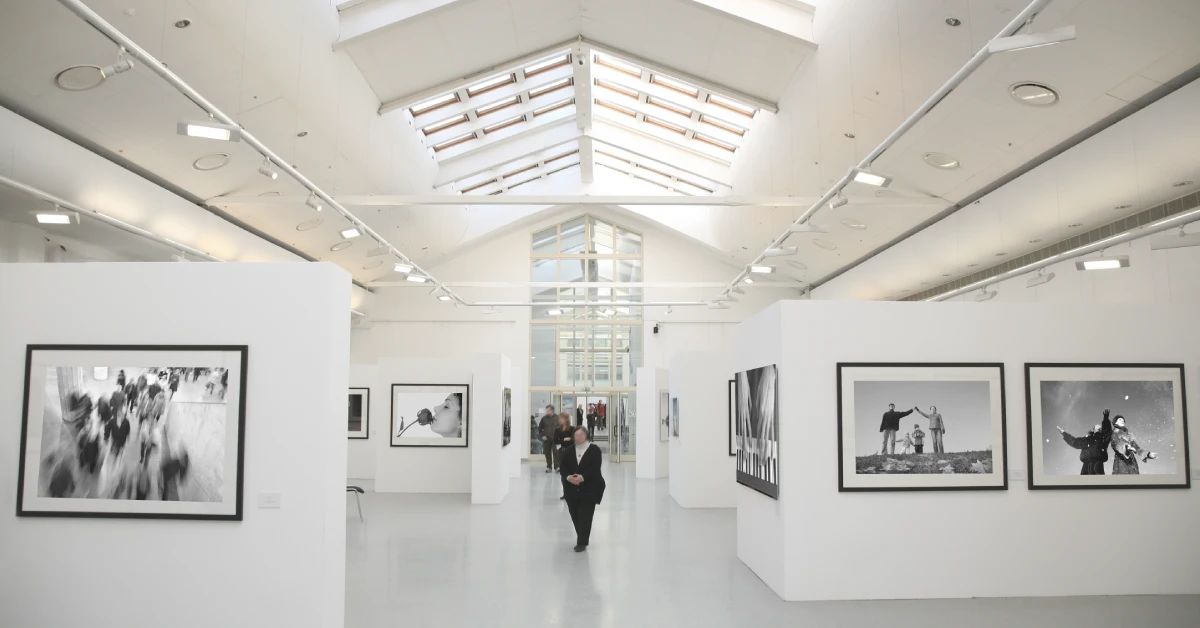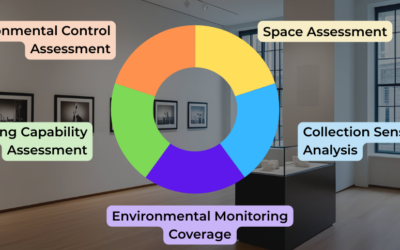There is so much to keep in mind when it comes to preventive conservation in a museum setting. Most of the time, the most prevalent metrics of temperature and relative humidity are front and center in the struggle to keep our cultural property for as long as possible, probably because mold is a particularly unpleasant enemy to fight. A less focused-on, as compared to temp & RH, but just as impactful agent of deterioration is light. There are so many facets to light levels in a museum, and they all have to be balanced with the curators’ need to put on a good exhibit.
“We can say that all organic material is at risk under light. The term ‘organic material’ includes all things which originated in animals or plants – for example, paper, cotton, linen, wood, parchment, leather, silk, wool, feathers, hair, dyes, oils, glues, gums and resins – and in addition, because of similarities in chemical structure, almost all synthetic dyes and plastics.”
Garry Thomson, “The Museum Environment”
Let’s explore some key questions around light levels in museums and how they impact preventive conservation goals as well as some mitigation strategies. What is the perfect combination for light levels in museums today? Is there such a thing? What is too much light? What are the best color temperatures? Can we fix light damage? Let’s try to break this down as simply as possible.
Measuring light in a museum setting
- Foot candles are an imperial measure for light intensity. It corresponds to the light of one candle illuminating one square foot of a surface at a distance of one foot. The amount of light received is called illuminance.
- Lux is the metric version of foot candles. It corresponds to the light of one candle illuminating one square meter of a surface at a distance of one meter.
- Lumens is another way of saying “candles”. It refers to the amount of light being emitted by a source. Lumens or candles will describe how much light a source gives out.
- Color temperature refers to how “cool” or “warm” a light feels. Is it blue-ish or white? That’s cool. Is it more orange or golden? That’s considered warm. It’s possible to find a wide range of color temperatures for different types of bulbs. Note that there is a report by the Commission Internationale de l´Eclairage (CIE) that suggests higher temperatures may have higher relative damage potential. Color temperature will also affect the way the object looks to the human eye. For this reason, lights in museums also take into account what light the original object may have been made under or what color the object is so that the light temperature of the lighting system may be chosen appropriately.
- Cumulative exposure is a simple multiplication formula that addresses the fact that light damage is cumulative over time. Multiply the amount of time an object is exposed to a light by the number of footcandles or lux on the surface of the object and divide it by 1000. This gives you a final number in kilofootcandles (kfc) or kilolux (klx) per hour per year. Measuring exposure to light like this means that light levels in museums can be flexible. You can light an object with intense light for a short amount of time, or light it with a weaker light for a longer period – once you run your calculation, the cumulative exposure is the same.
What are optimal levels of light?
“Optimal” light levels in museums can depend on the object, the general audience of the museum and curatorial choices. For example, older audiences generally tend to need higher light levels to appreciate smaller or subtler details. Curators may wish for a particular object to be lit more or less strongly depending on the meaning of the object or the vibe of the exhibition. Meanwhile, the object itself may be more or less sensitive to light damage depending on its component materials. Museums Galleries Scotland recommends the following levels in lux (using the metric system):
- 50 lux or less for very sensitive items such as furs, feathers, costumes and textiles, works on paper, transparencies and dyed leathers.
- About 200 lux for oil and tempera paintings, lacquerware, resistant plastics, wood, furniture, bone, ivory, undyed leather, minerals and modern black and white photography.
- Certain inorganic materials such as stone, ceramics, metals and glass are considered resistant and can take 300 lux.
Some materials are so sensitive that even 50 lux may be too much. According to guidelines by the Library of Congress, for example, early experimental photographs, motion picture films and degraded plastics should be kept in complete darkness with only limited exposure. Make sure you read our other post on Museum Lighting Guidelines for some open access articles to help you improve your lighting decisions.
How to reduce light exposure or limit the risk of light damage
• Lower light levels and limit UV exposure
- Lower the overall sunlight and electric lighting.
- Make sure your light sources are UV-free or UV-filtered and use a UV reader to make sure your objects are not exposed to high UV levels. (See Canadian Conservation Institute: Agent of Deterioration: Light, Ultraviolet and Infrared.)
- Selective shading by using covers, shades, or drawers to keep items in the dark until a visitor wishes to see them.
- Design strategies. It’s possible to play with light levels in different rooms in a successive order to make the human eye adjust to lower levels of light. If light levels are lowered progressively in one room after the next, by the time the visitor comes into the darkest room, they will be able to see objects they might have had trouble with if they had gone from bright to dim in one step. Playing with the color of the walls will also make the object on it look brighter or darker without changing light levels.
- How much light is too little? This question can be directly related to the age of your audience or any particular vision related challenges. Light levels in museums must take into account the requirements of different types of visitors to make exhibitions accessible and inclusive.
• Rotate collections (reduce time) / “Rest” time
It is common practice to rotate collections to reduce light exposure. This means that the amount of time an object is displayed will be limited, and the exposed object may go into a period of storage in the dark to “recover”. This kind of practice “spreads out” the light damage over several objects in a collection in order to prevent any one object from being completely lost over time. Rotating collections means that a museum must count with the available staff and resources to open display cases, move objects, potentially create new, specialized mounts, play with light levels, and conserve objects so they can go on display.
• “Sacrifice” an object
One 2107 study by Agnes Brokerhof suggests that there may be a tipping point for rotating collections. Sometimes, when the damage to an object has reached a certain level of light damage, collections managers may decide that it would be best to “sacrifice” that one in order to save other objects rather than to keep spreading the damage among various similar objects.
Best & worst types of museum lighting sources?
According to the Canadian Institute of Conservation, “In terms of lighting decisions, looking for differences between electric lamps that produce good-quality light, of any type, once their UV is removed is splitting hairs; the big preservation impacts are obtained by reduction in intensity and duration of exposure.” This said, all LEDs are not created the same, so make sure you look at specifications and buy only high-quality lamps. See Guidelines for Selecting Solid-State Lighting for Museums by the Getty Conservation Institute if you need some help deciding.
Can we fix light damage?
Unfortunately, light damage is both cumulative and completely irreversible, so preventing light damage is extremely important. You can use a combination of low-impact lighting systems, UV filters, rotation of objects to limit exposure, changing light levels in different rooms, automatic lighting systems that only turn on when visitors are around, or even simple systems with curtains or drawers so the object is only exposed while a visitor is looking at it.
With so many factors to consider, how can you decide on museum light levels for your spaces?
How can you make sure you are keeping your collections safe given the guidelines above? There are a lot of options of course, but luckily there are ways to simplify all of this information down into some “golden rules” to adhere to.
Here are some basic recommendations to maximize your impact in the battle against light damage:
- Make sure you know what materials are present in your objects and how resistant each one is to light damage.
- Measure lux in your spaces when you are setting up new displays. You can use handheld lux meters to take spot readings, but data loggers will be faster if you can get them. Conserv’s environmental monitoring platform will automatically log light readings wirelessly and calculate cumulative light hours for you in real time.
- Don’t buy the cheapest LEDs you can find. Just because they’re LEDs doesn’t automatically make them better. Invest in good quality lights.
- Don’t forget all visitors have different light level requirements and consider special shading measures to protect extra-sensitive objects.
- Document the time your objects are lit and on display. Some Collections Management Systems (CMS) have a dedicated space for this. Consider having a light exposure quota for sensitive objects and plan rotations around your staff availability.
Don’t miss our article on 7 Aspects To Consider when choosing museum lighting to make sure you are looking at all the right specs before you commit to buying.
If you have any questions about environmental monitoring, integrated pest management, or just want to talk about preventative conservation, please reach out to us! Don’t forget to check out our blog or join our community of collections care professionals where you can discuss hot topics, connect with other conservators or even take a course to get familiar with the Conserv platform.





